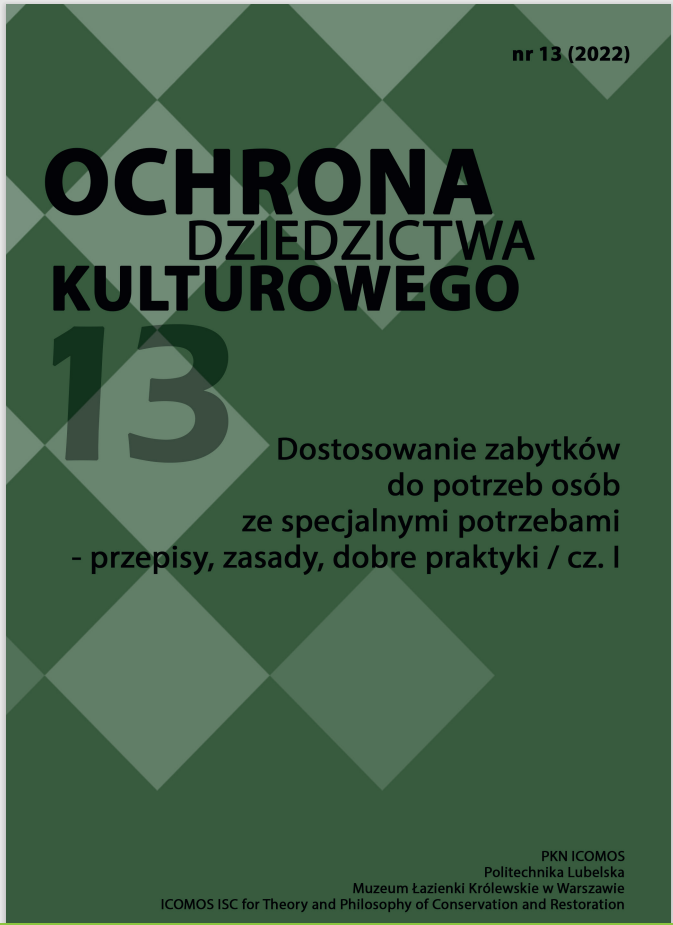Accessibility and Enhancement of Cultural Heritage: Examples of Best Practices in Europe
Article Sidebar
Open full text
Issue No. 13 (2022)
-
An Intricate Encounter? Cultural Significance and Accessibility in the Conservation of the Nineteenth- and Twentieth Century Monuments of Thessaloniki
Dimitrios Zygomalas7-24
-
Technological Artifices: Good Practices for Inclusive Communication in Museums
Gianluca D'Agostino, Cristina Boido25-36
-
Communicating a Conservation-Restoration Project: The Case of Chapel of Original Sin at the Sacro Monte di Varallo
Greta Acuto37-50
-
Accessibility of Cultural Heritage
Calogero Bellanca, Susana Mora Alonso-Muñoyerro, Cecilia Antonini Lanari51-68
-
Accessibility and Enhancement of Cultural Heritage: Examples of Best Practices in Europe
Rosa Anna Genovese69-84
-
Conservation Theory and the Accessibility of Monuments /on the Example of the High Castle in Malbork/
Grzegorz Bukal, Agnieszka Kowalska85-100
-
Authenticity and Interpretation for the Personal Appropriation of Heritage in Museums
Michela Benente, Valeria Minucciani101-110
-
The Role of Local Communities in the Discourse of Controversial Heritage of Norway and Estonia
Ave Paulus, Arnstein Bard Brekke111-128
-
Accessibility to the New Geoparq of Siurana
Josep Maria Adell-Argilés, Susana Mora Alonso-Muñoyerro, Dolores De La Piedra Gordo, Miguel García Jiménez, Edgar Lombana Echeverry129-142
-
From "Lodz Art" to "Friendly City". Good Practices or New Quality in the Dissemination of Cultural Assets?
Aneta Pawłowska, Daria Rutkowska-Siuda, Paulina Długosz143-158
Main Article Content
DOI
Authors
Abstract
Premise. The essay will report on actions promoted at international and national level, to ensure accessibility in different sectors of social life and reduce obstacles in this field in European regulations and in the practices of Member States.
The Convention adopted by UNO in 2006, stating that people with different abilities must enjoy fundamental rights and (political, economic, social, cultural) freedoms, constitutes the first great treaty of the twenty-first century concerning the change in attitude and strategies towards people bearing handicaps, to increase respect of their dignity through every possible measure.
Intercultural dialogue. In light of a greater awareness on environmental issues and possible solutions, we are, therefore, all called upon to contribute to changes in the relation with our one and only Planet in order to build a new conservation ethics, which may include the values of Cultural Heritage and accept, for its protection and enhancement, the contribution of Communities, favouring intercultural dialogue.
Best practices. The essay intends to stress the importance of integrated policies in promoting accessibility and the enhancement of cultural heritage, also through the examination of the best practices implemented in different European Countries. Specifically, it shall highlight how one of the criteria informing the Management Plan of the ‘Archaeological Area of Pompeii and Torre del Greco’ is based on the conservation of the archaeological heritage, with the purpose of making it accessible to the public while conserving the testimonial, formal and material features of the site, and addressing conservation issues as well as the design quality of accessibility improvements.
Integrated Conservation. The quality of conservation and restoration interventions on cultural heritage will, therefore, have to be perfected through an aware fact-finding analysis, favouring the application of scientific and digital technologies, paired with a diagnostic approach capable of including the digitalisation of processes, energy efficiency, accessibility, leading to the digital management of anamnesis and control of the restoration project, based on adequate knowledge of the cultural property and its state of conservation.
Keywords:
References
CEREMA (2015). Le Schéma directeur d’accessibilité des transports. Agenda d’accessibilité programmée. Guide méthodologiques d’élaboration, Éditions du Cerema, Bron.
CEREMA (2018). Coeurs de villes et villages accessibles à tous. Recueil de belles pratiques, Collection ‘Expériences et pratiques’, Cerema, Bron.
GENOVESE Rosa Anna (2013). Patrimonio culturale e accessibilità in Europa: indirizzi UNESCO e ICOMOS. In: ‘Pompei accessibile. Per una fruizione ampliata del sito archeologico’ (edited by PICONE R.), L’Erma di Bretschneider, pp.179-192, Rome.
GENOVESE Rosa Anna (2020), Il Piano strategico UNESCO e l’‘Insula Occidentalis’. In: GRECO G., OSANNA M. and PICONE R. (edited by), ‘Pompei Insula Occidentalis. Conoscenza Scavo Restauro e Valorizzazione’, L’Erma di Bretschneider, pp.107 -119, Rome.
LEON Alessandro (2013), Introduction to the ‘Piano di Gestione del Sito UNESCO. Aree Archeologiche di Pompei, Ercolano e Torre Annunziata’, pp. II e III.
MiBACT, GPP-Unità ‘Grande Pompei’(2015). Piano strategico per lo sviluppo delle aree comprese nel Piano di Gestione del Sito UNESCO ‘Aree archeologiche di Pompei, Ercolano e Torre Annunziata’. Proposals for possible interventions – Attached to Note nr.1987 in date 1.12.2015.
SABY Laurent (2011). L’accessibilité dans 11 villes européenne : recueil de pratiques en faveur des personnes a mobilité réduite (edited by Goepp A. and Saby L.), Editions CERTU, Collection Dossiers, July 2011. Cf. also : (2011), Actes de la journée d’échanges du 27 septembre 2011 à Montpellier, Editions CERTU, Collection Dossiers.
SABY Laurent (2013). Approches pragmatiques ou contraintes normatives des politiques d’accessibilité en Europe, report carried out on the occasion of the European Symposium organized by ICOMOS France, with the Patronage of UNESCO, ‘Patrimoines et accessibilité: Comment rendre accessibles à tous, les villes, les monuments et les sites protégés en Europe ? // Heritage and accessibility : how to make protected towns, monuments and sites in Europe barrier-free ?’ (Paris, 21/22 March 2013).
UNESCO (2012). The UNESCO Document of the first ‘Congrès mondial de l’accessibilité universelle’ (Paris, 19-20 January 2012).
UNO (2006). The entire Document of the UNO Convention (United Nations Organisation), Convention relative aux droits des personnes handicapées et Protocole facultatif, adopted on 13 December 2006, was approved by 82 signees for the Convention and 44 for the discretionary Protocol.
Article Details
Abstract views: 249
License

This work is licensed under a Creative Commons Attribution-ShareAlike 4.0 International License.






